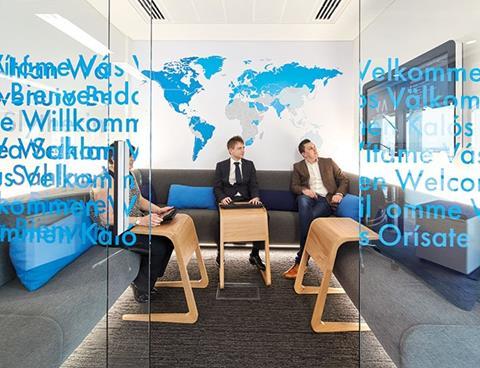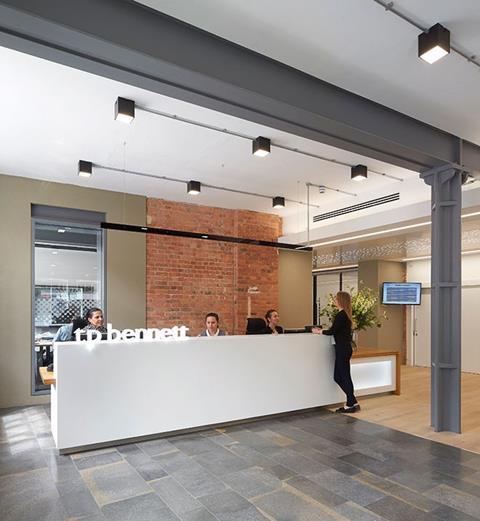This CPD focuses on how one architecture practice, TP Bennett, addressed the challenges of managing project data. It is sponsored by Newforma

How to take this module
UBM’s CPD distance-learning programme is open to anyone seeking to develop their knowledge and skills. Each module also offers members of professional institutions an opportunity to earn between 30 and 90 minutes of credits towards their annual CPD requirement.
This article is accredited by the CPD Certification Service. To earn CPD credits, read the article and then click the link below to complete your details and answer the questions. You will receive your results instantly, and if all the questions are correctly answered, you will be able to download your CPD certificate straight away.
CPD CREDITS: 30 MINUTES
DEADLINE: 20 NOVEMBER 2015


INTRODUCTION
Construction projects involve the production, management and retrieval of increasingly large amounts of information. This includes models, drawings, emails, mark-ups, submittals, transmittals, meeting minutes, images, contracts, specifications, change orders and other documentation that is created in the course of designing, building and operating large facilities.
Files will be in a diverse range of file formats, and some may be very large. Nevertheless, they must be easily but securely shared among team members across different organisations and technology platforms, and stored in a searchable format for future reference.
�ڶ����� information modelling (BIM) has both increased the volume and complexity of construction project information, and also the need to collaborate across teams.
The government’s 2011 BIM strategy paper mandated the implementation of “level 2” BIM on all public-sector construction projects by 2016. This was defined as a situation in which each discipline creates its own model, which is shared throughout the team, with all project data available electronically as part of a common resource.
In February of this year, the government published the follow up: the Digital Built Britain strategy, which set out the next steps to “level 3” BIM. This envisages a construction environment where the use of technology is second nature and where wasteful practices such as duplication of work between different disciplines are eliminated through “data-enabled collaborative working”.
According to the Cabinet Office, the use of level 2 BIM on projects has delivered £804m worth of savings on government case study projects in 2013/14, a 20% saving on capital expenditure compared with 2009/10 benchmarks. It believes this could be increased to 33% when whole-life cost savings are taken into account – as facilities management is also integrated into the BIM process and in-use building data becomes available to inform design work.
This will present building designers with an ever-increasing need to share, store and access an unprecedented range of data sources over a building’s lifespan.
This CPD focuses on how one architecture practice, TP Bennett, addressed the challenges of managing project data.
CONSIDERATIONS FOR INFORMATION MANAGEMENT
TP Bennett has offices in London, Moscow, Abu Dhabi and New York and employs around 300 people worldwide. It has three core divisions of architecture, interiors and planning, supported by specialist practice areas in strategy, research and graphics. Like many architecture practices, it currently faces a number of IT challenges. It must respond to a more complex operating environment while also enabling staff to work in many different locations around the world, including at home. “In addition, we have to provide a secure and resilient environment that deals with data that is more akin to much larger organisations,” says IT director Stephen Yates. “Our priorities are facilitating users, securing data and growing the technology alongside the aims and strategic ambitions of the business. In essence it’s about resilience, agility and security.”
In particular, Yates had been fielding requests from the practice’s architects, designers and planners who were seeking a better way to manage their email. They wanted to be able to file email with other project information, retrieve it with ease and maintain associations between emails and their attachments.
“The face of design and construction has changed significantly, with email becoming the primary means of communication,” explains Yates. “The way in which we as a consultant interact with the entire team is primarily through email so we needed to make what is in effect an insular means of communication into a team-based facility, while also securing the data. It is essential that we have the ability to search and find emails at a very granular level, so any product or system we put in place needs to meet that criteria as a minimum.”
The chosen solution also had to support compliance with its ISO 9001 quality management system (QMS). The ISO 9000 series of standards is the main set of international standards applying to the management of quality systems. It includes ISO 9001, the key internationally agreed standard for a QMS. To achieve ISO 9001 certification, a company needs to fulfil a large number of requirements, including control of documents via a documented procedure and the control and maintenance of quality records. A new version of the standard, BS EN ISO 9001:2015, is due to be released shortly, updating and replacing the 2008 version.
TP Bennett must also meet data-sharing standards set by its insurers, and by Wren, a mutual organisation that provides professional indemnity insurance to architecture practices. On top of this, clients frequently impose their own requirements for how files are exchanged and stored, particularly where BIM is used.

EXCHANGING LARGE FILES
The practice also required a way to exchange large files – an increasing challenge as building models grow in size and complexity. “Because we limit email attachment sizes to 15 megabytes, email is not a good way to share large files,” says Yates. “People might have to segment a large package of data into multiple packets and send multiple emails to get the whole package to a client.”
An alternative option was to use an FTP site. FTP stands for file transfer protocol, a standard network protocol used to transfer files from one host to another over a TCP/IP network such as the internet. Using FTP, files can be transferred using a web browser or a dedicated FTP application. Users log on to an FTP server, navigate the server’s folder structure and upload and download files directly.
The problem for Yates is that FTP sites are not auditable. Ever since TP Bennett first adopted the Windows platform back in 1992, this had been an option for file transfer: “However it very quickly became an issue once the internet kicked in properly and we actively discouraged it. We now do not allow it except under very controlled conditions, because of the issues around security and the need for very specific configurations and applications.”
Another option is to use a project extranet. This is a dedicated network or portal that allows controlled access from the outside. It enables project stakeholders from different organisations to share files and collaborate on projects remotely and securely, without allowing external parties to access their own corporate networks. The downside is that project extranets cannot be integrated into internal processes, particularly with email.
IMPLEMENTATION
Having considered these options, Yates decided to implement Newforma Project Center software to file, share and search emails, and to use its web component, Newforma Info Exchange, to transfer large files. This maintains a record of who downloaded what and when, and allows managers to generate activity reports and set up automated email reminders to those that have not yet downloaded files. Users are also able to store information on the Info Exchange server indefinitely or schedule expiration dates, preventing a build up of unnecessary files.
Yates is now moving archived projects from backup tape to servers, from which Newforma Project Center can index the data, making it fully searchable. As part of a network upgrade, the TP Bennett IT team is reassigning an old HP MSA1500 storage area network to a new role as an archive server.
“Questions arise all the time regarding completed projects,” he says. “The answers are in the archives, but the process of retrieving the relevant information was a laborious and manual slog. Newforma Project Center provides a simple way to search the full text of email and other project information, so we now have a practical way to retrieve answers quickly.”
The software also offers a range of other tools which enable users to capture images from their screens, mark-up documents, action issues, and view files produced in other programmes, such as AutoCAD, without having the underlying authoring software installed.
Implementing the software did require some staff training, though this was relatively straightforward: “In all projects where culture change is required training is essential, particularly in this case because the trade-off was a reduction in the user mail account limit. But this was an easy win because the software ticked the boxes for people and is easy to use.”

ADVICE FOR OTHER FIRMS
- When investigating different software options, carefully consider who is involved in the demos. Ensure that the top-level management are fully on board and back the project.
- Consider the implementation process in terms of both the technical IT project management and, more importantly, user buy-in.
- Ensure you have the capacity to implement a comprehensive training programme – and make it compulsory. In addition, you cannot do too many FAQs and help documents. Software vendors such as Newforma can offer a considerable amount of literature, but you will need to produce your own guides to linking to the new product internally and via remote access.

How to take this module
UBM’s CPD distance-learning programme is open to anyone seeking to develop their knowledge and skills. Each module also offers members of professional institutions an opportunity to earn between 30 and 90 minutes of credits towards their annual CPD requirement.
This article is accredited by the CPD Certification Service. To earn CPD credits, read the article and then click the link below to complete your details and answer the questions. You will receive your results instantly, and if all the questions are correctly answered, you will be able to download your CPD certificate straight away.
CPD CREDITS: 30 MINUTES
DEADLINE: 20 NOVEMBER 2015
Privacy policy
Information you supply to UBM Information Ltd may be used for publication and also to provide you with information about our products or services in the form of direct marketing by email, telephone, fax or post. Information may also be made available to third parties. UBM Information Ltd may send updates about �ڶ����� CPD and other relevant UBM products and services. By providing your email address you consent to being contacted by email by UBM Information Ltd or other third parties. If at any time you no longer wish to receive anything from UBM Information Ltd or to have your data made available to third parties, contact the Data Protection Coordinator, UBM Information Ltd, FREEPOST LON 15637, Tonbridge, TN9 1BR, Freephone 0800 279 0357 or email ubmidpa@ubm.com. View our full privacy policy at




















2 Readers' comments